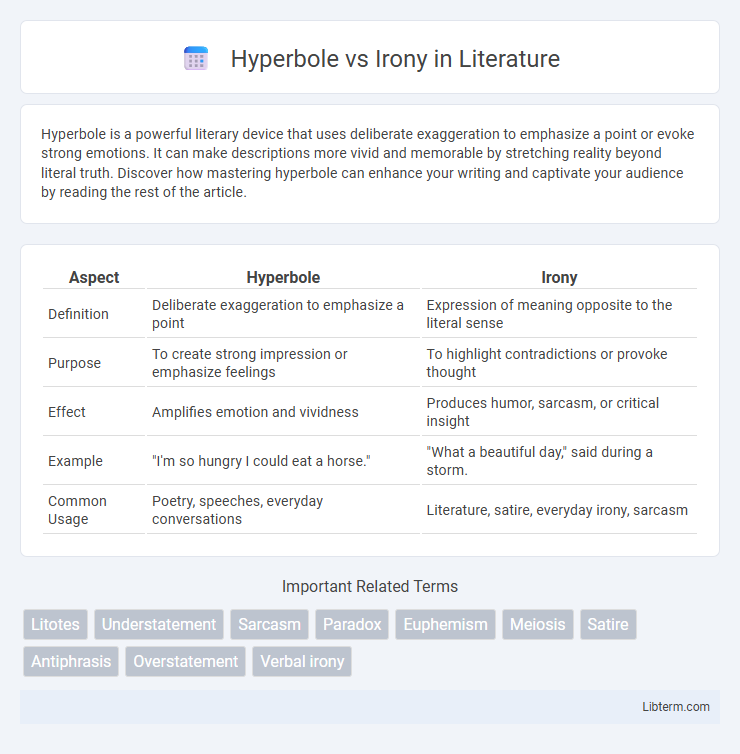Hyperbole is a powerful literary device that uses deliberate exaggeration to emphasize a point or evoke strong emotions. It can make descriptions more vivid and memorable by stretching reality beyond literal truth. Discover how mastering hyperbole can enhance your writing and captivate your audience by reading the rest of the article.
Table of Comparison
| Aspect | Hyperbole | Irony |
|---|---|---|
| Definition | Deliberate exaggeration to emphasize a point | Expression of meaning opposite to the literal sense |
| Purpose | To create strong impression or emphasize feelings | To highlight contradictions or provoke thought |
| Effect | Amplifies emotion and vividness | Produces humor, sarcasm, or critical insight |
| Example | "I'm so hungry I could eat a horse." | "What a beautiful day," said during a storm. |
| Common Usage | Poetry, speeches, everyday conversations | Literature, satire, everyday irony, sarcasm |
Introduction to Hyperbole and Irony
Hyperbole is a figure of speech that involves deliberate exaggeration to create emphasis or evoke strong feelings, often making statements more dramatic or humorous. Irony, in contrast, involves expressing meaning by using language that usually signifies the opposite, commonly highlighting discrepancies between appearance and reality. Both rhetorical devices are essential in literature and everyday communication for enhancing expression and engaging the audience.
Defining Hyperbole in Language
Hyperbole is a rhetorical device characterized by deliberate and extreme exaggeration used to emphasize a point or evoke strong emotions in language. Unlike irony, which conveys meaning opposite to the literal interpretation, hyperbole amplifies reality to create vivid and impactful expressions. Common in literature and everyday speech, hyperbole enhances persuasive communication and artistic creativity by stretching facts beyond literal truth.
Understanding Irony: Types and Usage
Irony encompasses various forms such as verbal, situational, and dramatic irony, each serving to highlight contrasts between expectation and reality. Verbal irony involves saying the opposite of what one means, often for humorous or emphatic effect, while situational irony occurs when the actual outcome differs sharply from what was anticipated. Dramatic irony arises when the audience possesses knowledge unknown to characters, enhancing engagement through suspense or humor in literature and media.
Key Differences Between Hyperbole and Irony
Hyperbole involves deliberate exaggeration to emphasize a point or evoke strong emotions, while irony conveys a meaning opposite to the literal words, often for humorous or sarcastic effect. Hyperbole magnifies reality to an extreme, whereas irony relies on contrast between expectations and actual outcomes. Understanding their use in literature enhances interpretation of tone and intent.
The Role of Context in Interpreting Both Devices
Context plays a crucial role in interpreting hyperbole and irony by providing cues that clarify whether an exaggerated statement is meant to emphasize a point or convey sarcasm. In hyperbole, context helps determine that the overstatement is not literal but intended to create a dramatic effect, such as "I'm so hungry I could eat a horse." In irony, contextual signals reveal the speaker's true intent, often indicating the opposite of the literal meaning, as in saying "Great weather" during a storm.
Hyperbole in Literature and Everyday Speech
Hyperbole, a deliberate exaggeration used for emphasis or effect, is a prominent literary device that amplifies emotions and highlights key themes in literature. In everyday speech, hyperbole enhances storytelling by intensifying impressions and making descriptions more vivid and memorable. Unlike irony, which often conveys a contrast between expectation and reality, hyperbole magnifies reality to evoke strong reactions and underscore meaning.
Irony’s Impact on Tone and Message
Irony subtly shapes tone by introducing layers of meaning that contrast with surface expressions, often creating humor, sarcasm, or critical commentary. Its impact on message lies in engaging readers to interpret underlying intentions, which can enhance persuasive power or reveal deeper truths. This nuanced communication style sets irony apart from hyperbole, which relies on exaggeration for emphasis rather than contrast.
Common Examples of Hyperbole and Irony
Hyperbole commonly appears in phrases like "I'm so hungry I could eat a horse" or "I've told you a million times," exaggerating for dramatic effect. Irony is often found in statements where the intended meaning contrasts with the literal one, such as saying "What a beautiful day" during a storm or describing a disastrous event as "just perfect." Both devices serve to emphasize meaning, with hyperbole magnifying reality while irony highlights contradictions or unexpected outcomes.
Misconceptions and Overlaps: Clearing the Confusion
Hyperbole and irony are often confused due to their shared use of exaggeration, but hyperbole intentionally amplifies facts for emphasis, while irony involves a contrast between expectation and reality. Misconceptions arise when hyperbole is mistaken for sarcasm, a form of verbal irony that implies the opposite of what is said. Understanding their distinct functions clarifies communication and enhances literary analysis by recognizing hyperbole's role in intensification and irony's in highlighting contradictions.
Conclusion: When to Use Hyperbole or Irony
Hyperbole is best used to emphasize strong emotions or exaggerate for dramatic effect in storytelling, advertising, or persuasive writing. Irony suits contexts where subtlety or humor is needed to highlight contradictions, critique situations, or create deeper meaning. Choosing between hyperbole and irony depends on the desired impact: exaggeration for clear emphasis versus irony for nuanced or sarcastic commentary.
Hyperbole Infographic

 libterm.com
libterm.com